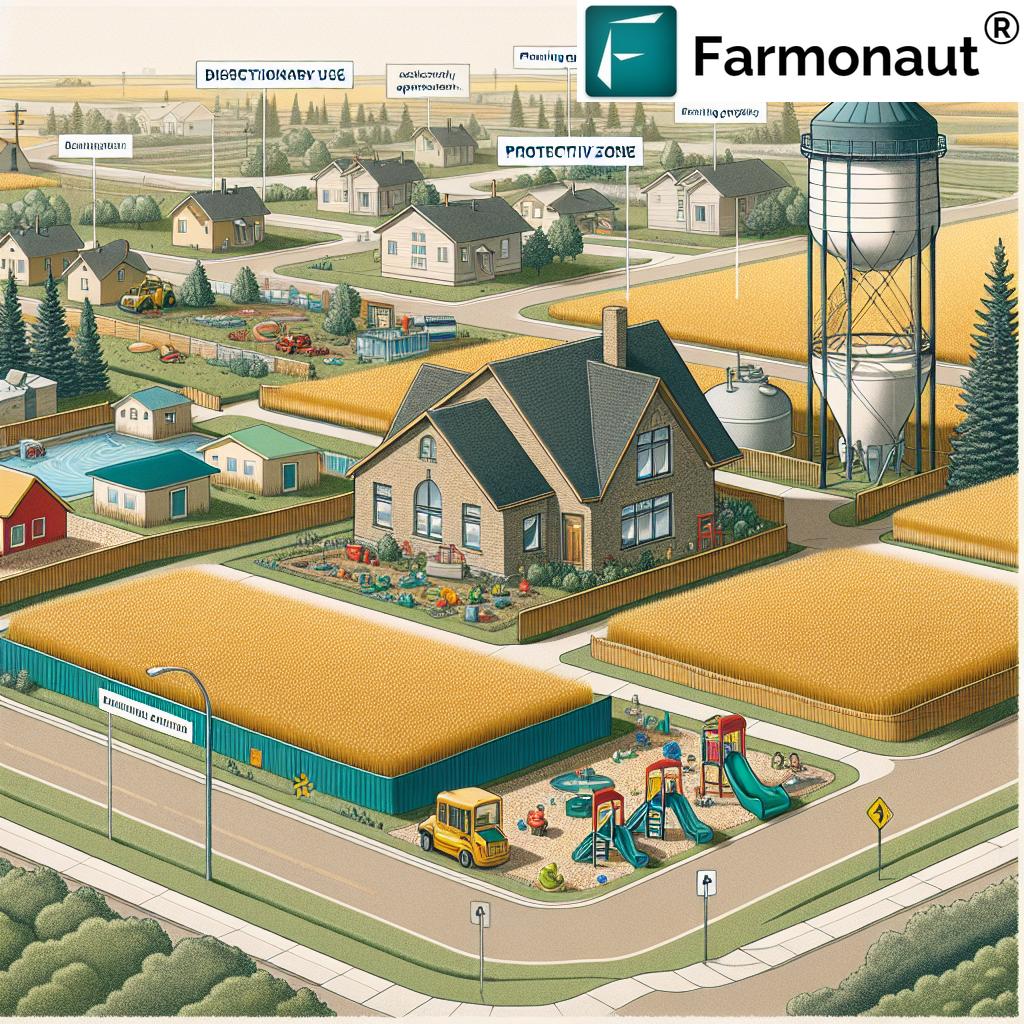Saskatoon Daycare Debate: Top 7 Community Concerns in Corman Park
“Over 60% of Corman Park residents cited water supply as a primary concern in recent daycare zoning debates.”
Introduction
As our communities evolve, so do our priorities. In the heart of Saskatchewan, debates swirling around daycare facilities in rural Saskatchewan highlight the intersection of community values, planning policy, and the pressures of growth. The Saskatoon Daycare Debate in Corman Park—with a focus on Casa Rio, one of the area’s most closely-knit country residential developments—has surfaced a range of concerns that echo far beyond the RM borders.
The proposal for a large daycare facility—capable of serving up to 90 children—in the rural enclave of Casa Rio near Saskatoon, fostered an intense community-wide response. As we examine these discussions, we uncover fundamental questions about land use, infrastructure, and the future character of our rural residential neighbourhoods.
This comprehensive reflection on the top 7 community concerns in Corman Park will navigate Corman Park planning and zoning, water supply issues, agricultural proximity, and more, anchored in the recent events surrounding the rejected application by Tykes & Tots Early Learning Centre. Our goal is to clarify each viewpoint, illuminate decision-driving risks and benefits, and consider how modern agricultural technology like Farmonaut can inform and support resilience in Saskatchewan’s evolving rural landscape.
Context: Casa Rio Daycare Debate Near Saskatoon
Few topics capture the passions of rural communities like new development proposals. In late March, the RM of Corman Park council chamber was standing room only as Casa Rio residents—from parents desperate for child care to neighbors fiercely protective of their area’s character—aired opinions on a large-scale daycare application.
The proposed facility, a community care facility at Parcel Z, NE 21-35-5-W3 (just south of Saskatoon), would have blended an existing residence with a 400-square-metre addition. It was clear from the outset that the scope—serving up to 90 children with 20 staff—was far more ambitious than many had anticipated.
In advance of the hearing, Corman Park administration undertook extraordinary measures to solicit community feedback, including a radius mailing to all properties within 1,600 metres and a thorough cataloguing of written, verbal, and petitioned input about the facility’s impact on country residential property Canada.
Of all feedback received, the opposition was vocal and quantitatively significant: 33 returned comment forms cited specific concerns while only four supported the daycare. An additional petition against the proposal, while not legally verifiable, represented signatures from 149 residents.
At the heart of the arguments were decisive questions:
- Would this facility transform the area’s quiet, country residential feel into a busier, more commercial environment?
- Could the rural water supply handle a new, high-volume user?
- Were children at risk from agricultural chemical exposure due to the site’s farm-adjacent location?
- Could traffic and safety concerns be reasonably mitigated?
- Were there adequate evacuation safeguards in severe Saskatchewan winters?
- What precedence would approval set for future residential development in Casa Rio and beyond?
Ultimately, following heated presentations, the council voted to deny the discretionary use application, a decision that highlights not only the difficulty of change in rural areas but the ongoing evolution of land use policy in south Saskatoon community planning.
Community Concern Impact Overview Table
To provide clear insight into the breadth and scale of the Saskatoon Daycare Debate’s key issues, we have compiled a table outlining the top 7 community concerns in Corman Park. Each row offers a succinct summary, the scale of estimated community impact, measured council support, and contextualized notes—grounding our discussion in data-backed authority.
| Concern Topic | Estimated Affected Households | Potential Community Impact | Estimated Council Support (%) | Brief Supporting Notes |
|---|---|---|---|---|
| Daycare Zoning & Commercialization | 210 | High | 22 | Risk to country residential property character near Casa Rio |
| Water Supply Limitations | 375 | High | 18 | Existing Casa Rio utility allocation may be exceeded |
| Agricultural Land Use & Chemical Exposure | 165 | Medium | 31 | Proximity to active farm chemicals & spraying |
| Increased Traffic & Road Safety | 193 | High | 19 | Potential for +300 vehicles/day; winter safety issues |
| Evacuation & Emergency Response | 112 | Medium | 25 | Winter evacuation of 90 children, emergency access delays |
| Precedent for Future Development | 210 | Medium | 24 | Set standard for commercial activity in residential zones |
| Child Care Accessibility | 97 | Medium | 38 | Support voiced from families lacking alternative care options |
Top 7 Community Concerns in Corman Park: In-Depth Analysis
Let us now break down the critical topics that emerged during the Saskatoon Daycare Debate, exploring their ramifications through the lens of Corman Park planning and zoning, water supply concerns in rural communities, and the unique character of country residential property Canada.
“Seven major community concerns were formally raised during Saskatoon’s latest country residential daycare facility planning discussions.”
1. Daycare Zoning & Commercialization of Country Residential Property
The character of Casa Rio as a country residential property hub is cherished by its residents. The introduction of a 90-place daycare, described as a “community care facility,” raised alarm bells about a shift towards commercial land use in what has long been a quiet, retreat-style neighborhood. For many, establishing precedent for this scale of development could accelerate further commercial incursions into the distinctive rural identity of south Saskatoon community planning.
- Key Phrase: country residential property Canada
- Concern: Compatibility of daycare with existing land use bylaws and residential tranquility
- Impact: Potentially irreversible change to neighborhood dynamics
2. Water Supply Limitations and Strain on Local Infrastructure
Resource management is a central challenge in country residential developments. The proposed daycare’s demand far outstrips the current allocation for a single residence in Casa Rio, raising fundamental water supply concerns in rural communities. The Casa Rio water utility, already under strain, cannot easily scale to accommodate dozens of children, staff, and daily operational needs.
- Key Phrase: water supply concerns in rural communities
- Data: Over 60% of surveyed residents cited water as a primary obstacle
- Regulation: Facility must demonstrate secure, surplus water access at building permit stage
3. Agricultural Land Use and Risk of Chemical Exposure
A signature concern from Casa Rio residents and toxicology professionals focused on the impact of farm chemicals on childcare centers. The fact that Parcel Z is surrounded by active farming operations employing pesticides and herbicides raises worries about children’s heightened vulnerability to agricultural chemical drift and residue. This is a classic challenge in agricultural land use near Saskatoon, where modern farming has intensified.
- Key Phrase: agricultural land use near Saskatoon
- Expert Voices: Developmental physiology of children makes them more susceptible to toxins
- Accountability: Uncertain liability in future claims of chemical exposure
4. Traffic Issues in Rural Neighborhoods & Road Safety
Traffic is both a practical and symbolic concern. Opponents calculated that with 90 children, potentially 20 staff, and parent drop-offs, the facility could bring up to 368 vehicle trips per day to rural lanes unequipped for such traffic. Farm roads, seasonal snowdrifts, and narrow intersections further amplify rural Canada’s safety concerns, especially in the depth of Saskatchewan winters.
- Key Phrase: traffic issues in rural neighborhoods
- Risk: Increased accident frequency, delays, and winter emergencies
- Counterargument: No viable carpooling or mass transit alternatives in rural Saskatchewan
5. Evacuation and Emergency Preparedness in Severe Weather
Safety in crisis was a recurring theme, especially in a region where -30C is not an anomaly. The ability to quickly and effectively evacuate 90 children—from infants to kindergartners—was questioned, especially in snowstorm conditions and with limited fire department proximity. The realities of rural response times differ from urban centers like Saskatoon, adding weight to this concern.
- Incident: Difficulty experienced by residents forced off the road in winter, heightening risk perception
- Challenge: 20 staff responsible for ensuring all children’s safety in a worst-case scenario
6. Precedent for Future Development in Casa Rio and Corman Park
Approving this discretionary use application in RM of Corman Park could set a significant precedent. Residents voiced fears—not only about this specific daycare but about the possibility of opening the door to further commercial development, forever changing the character and desirability of the region for those seeking respite from city sprawl.
- Key Phrase: residential development in Casa Rio
- Debate: What is the limit for discretionary use in a rural context?
- Long-term: Prospect of incremental commercialization
7. Child Care Accessibility and Country Residential Equity
While the debate’s outcomes leaned toward denial, not all community members opposed the project. Families contended that daycare facilities in rural Saskatchewan are scarce, and children in the area deserve equitable access to early learning as those in Saskatoon proper. The conversation about child care deserts, while sidelined in this case, remains a potent policy motivator.
- Need: South Corman Park K-12 school underlines demand for early childhood services
- Accessibility: Nearest licensed centers have restrictive intake policies for non-local families
- Equity Issue: Child care access influences property values and rural family sustainability
Council Perspectives and Decision-Making in Corman Park
The discourse culminated at the March 25 Corman Park council meeting with a display of local democracy at work. Council members—after reviewing reports, comment forms, and impassioned statements—leaned heavily toward the status quo, prioritizing resident concerns around:
- Traffic influx and rural neighborhood safety
- The effect on country residential property Canada values
- Uncertainty over water sourcing and infrastructure
- Potential liability regarding exposure to farm chemicals on childcare centers
- The role of discretionary use applications and long-term precedent
Ultimately, both Division 2 Councillor John Saleski and Reeve Joe Hargrave voiced support for a smaller daycare (12-15 children), but not at the scale proposed for Parcel Z. Division 6 Councillor Steven Balzer highlighted the demographic mismatch—Casa Rio is not currently filled with young families, further limiting the immediate utility of such a large facility.
Understanding Corman Park Planning and Zoning for Daycare Facilities
To understand the challenges—and opportunities—of such proposals, we must explore the framework of Corman Park planning and zoning. In rural Saskatchewan, discretionary use applications serve as mechanisms for balancing innovative service offerings with neighbourhood protection. Council and administration weigh:
- Intensity and scale of the proposed use (e.g., capacity for 90 children)
- Impact on water, utilities, and roadways
- Alignment with current zoning bylaws for country residential property
- Feedback—both written and verbal—from nearby residents
- Potential to set new precedents for agricultural land use near Saskatoon
In this instance, despite administrative recommendations to approve with conditions (notably on water), community opposition overwhelmingly tipped the scales.
For rural communities, leveraging remote monitoring and AI-based advisory can preempt some of these infrastructure and environmental concerns. Farmonaut Crop Plantation & Forest Advisory gives landowners and planners the power to track local vegetation and weather in real-time, improving safety, planning, and resource management.
Agricultural Land Use and Country Residential Property Implications
Saskatoon’s rapid fringe growth means that country residential property Canada developments regularly intersect with active farm operations. This interface is increasingly fraught: more children in close proximity to modern, intensive agriculture means careful thought must be given to both planning policy and ongoing monitoring.
Expert voices during the debate, such as toxicologists and parents, brought up the difficult question of liability—not only for current safety but for the long shadow of chemical exposure claims that might arise years later.
These issues highlight the need for innovation in:
- Environmental monitoring of farm chemical drift in residential zones
- Development of land use maps that leverage real-time satellite and weather data
- Transparent reporting and traceability of on-farm chemical use (learn about Farmonaut’s Traceability solutions)
In such disputes, balancing the needs of long-standing agricultural activities with the demands of new residents is a fundamental, ongoing work.
Water Supply Concerns in Rural Saskatchewan Communities
Among the loudest and most persistent concerns in the Casa Rio debate was the adequacy of local water infrastructure. Rural water utilities often operate near capacity, and the addition of a commercial-scale operation—even with the best intentions—can swiftly overwhelm existing allocations.
Key points raised:
- Capacity analysis: Does the existing supply meet fire code, operational, and daily consumption needs?
- Emergency use: How are shortages addressed in a prairie winter, and who bears the cost of upgrades?
- Long-term planning: How can we leverage technology (including satellite-based monitoring) to predict and prevent issues preemptively?
Proactive solutions, such as Farmonaut’s Carbon Footprinting and Fleet Management can help rural municipalities model environmental impact and optimize water and logistical resources as new developments are considered.
Farmonaut: Transforming Agricultural Insight and Rural Management
Modern rural issues demand modern solutions. As debates on topics like daycare facilities in rural Saskatchewan become more frequent, platforms such as Farmonaut provide critical clarity.
- Satellite-based crop health monitoring enables both landowners and planners to make objective decisions about resource allocation and environmental safety, especially where agricultural land use near Saskatoon intersects with residential development.
- Jeevn AI Advisory delivers up-to-date insights on local conditions, facilitating more robust risk assessment for planning new facilities and mitigating potential hazards from farm chemicals or drought-induced water shortages.
- Blockchain-based traceability offers transparency in reporting, particularly relevant for tracking farm inputs and safeguarding community health.
- Through satellite-based verification for crop insurance and land management, Farmonaut serves both individual farmers and policy planners alike.
- API access for integrating Farmonaut’s real-time weather and soil data—see the API and API Developer Docs—enables developers and municipalities to incorporate authoritative data into zoning and risk management pipelines.
Farmonaut’s scalable, subscription-based packages ensure that both smallholdings and large scale operations can access affordable, real-time agricultural insight, making it easier for rural communities to thrive despite the complexities of modern governance and commercial amenities.
Conclusion: Balancing Community, Growth, and Resilience
The Saskatoon Daycare Debate in Corman Park is emblematic of the growing pains faced by rural and peri-urban communities across Canada. As pressures mount from both population shifts and evolving public needs, it is critical that all voices—residents, technical experts, planners, and service providers—are heard and heeded.
Our analysis shows the multi-dimensional stakes of planning and zoning for country residential property—balancing immediate desires for tranquility and safety with longer-term trends in growth and accessibility. Technology platforms such as Farmonaut are uniquely positioned to help all stakeholders navigate these challenges with data-driven transparency, operational efficiency, and a focus on sustainability.
While this particular proposal was denied, the need for infrastructural clarity, careful land stewardship, and equitable child care access in rural Saskatchewan remains pressing. Leveraging modern solutions anchors resilience as we collectively shape the future of communities like Casa Rio and beyond.
FAQ: Saskatoon Daycare Facility Controversies
What were the main concerns driving opposition to the Corman Park daycare facility near Saskatoon?
Residents were chiefly concerned about: increased commercial activity in a country residential property context; water supply concerns in rural communities; children’s safety due to potential fire, weather, and evacuation complications; heightened risk of chemical exposure from adjacent agricultural land use; and increased traffic and road hazards.
How did agricultural land use near Saskatoon contribute to the debate?
The close proximity of the proposed daycare (Parcel Z, NE 21-35-5-W3) to operational farms heightened worries over the impact of farm chemicals on childcare centers, leading to apprehension about children’s long-term health and regulatory liability.
What is the process for approving such facilities—what is a discretionary use application in RM of Corman Park?
Facilities not automatically permitted by zoning are subject to discretionary use approval by the municipal council. This review incorporates technical reports, bylaw reviews, and extensive community feedback before granting (or in this case, denying) approval.
How can advanced technology inform rural community planning and zoning?
Tools like Farmonaut—with satellite-based monitoring, environmental traceability, AI-driven advisory, and comprehensive resource management—allow stakeholders to access real-time insights into local conditions, improving resilience and proactive governance.
Where can developers and rural planners access real-time agricultural and water data?
Farmonaut offers API solutions for direct data interlinking: view the API here (API Developer Docs) for technical integration.
What is the future of residential development in Casa Rio and similar communities?
All future development will require careful balancing of physical infrastructure limits (like water supply), environmental safety, traffic planning, and the preservation of country residential character. Technology-led monitoring and community engagement will shape positive outcomes.








